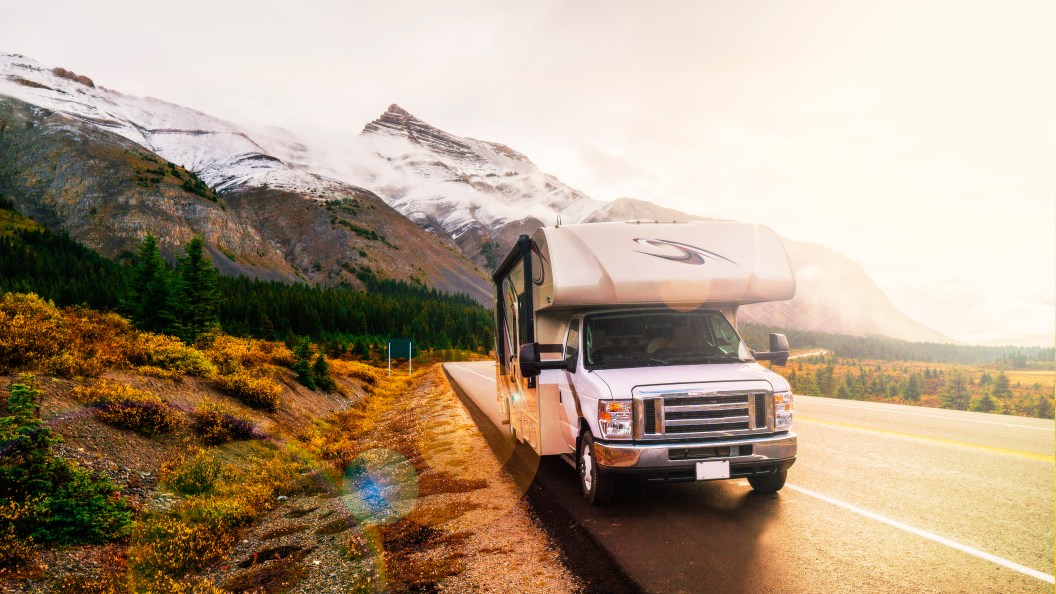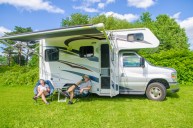Nothing holds allure like the great American road trip. While we love car camping and staying at kitschy motels, nothing beats the convenience of having a comfortable, all-in-one adventuremobile like taking an RV camping. A recent report from Kampgrounds of America (KOA) found that roughly 15 million households went RVing in 2022 alone, and a whopping 50% of tent campers would consider switching over to an RV—that is, if money wasn't an issue.
RV camping is certainly a bit pricier than tent camping, Paul Bandstra, a national sales executive for Campspot and a full-time RVer, told Wide Open Spaces. For starters, you need to buy or rent the vehicle itself. Then, you need special campsites for an RV. "Many tent sites are smaller, and most do not have water or electric hookups," he said. "When it comes to RV camping, you will most likely need to have water, electric, and sewer hookups to meet all of your needs."
Plus, the larger your rig, the more likely you will need to take on an increased nightly charge. In addition, RVs require a lot of fuel—which can definitely run up your bill. Diesel RVs come with a 90-gallon fuel tank, while gasoline-powered RVs have an 80-gallon fuel tank.
But don't let these factors deter you. Whether you're looking to experience RV life for a few days or are planning to do a complete 360 and transition to RVing full time, here are some ways you can embark on your grand adventure without breaking the bank.
1. Rent Instead of Buying
A few companies allow campers to rent an RV to get a feel for RV-style camping before purchasing one themselves. On these sites, RV owners list their rigs, so campers have a variety of options to choose from. By renting an RV, you can enjoy the great outdoors sans the maintenance and storage costs that are usually associated with ownership.
For example, RVshare—aka the Airbnb for RV rentals—allows campers to choose a pickup location, enter the duration for the rental, and note the number of guests coming. For a weeklong rental with a pickup location based in or located near Austin, Texas, rentals range between $48 and $400 per night. Other options include RVezy, Outdoorsy, and Cruise America.
2. Purchase a Campsite Membership
Part of the cost of RVing comes from campsite parking. Luckily, sites such as Thousand Trails offer an annual membership for long-term RVers to rent at a campground across North America. (Bandstra notes that the region you purchase and where you plan to camp will determine how many places are available through that membership.) From serene fishing lakes in Texas to resort destinations in Florida, you'll have access to campsites located across 80 locations in 22 states and British Columbia.
READ MORE: 9 Best Sun Outdoors RV Resorts to Stay at During Your Next Adventure
That being said, if you're only planning to head out for one or two nights, a membership might not make as much sense as one-off campgrounds. In this case, Bandstra recommends Harvest Hosts and Boondockers Welcome. Both companies offer unique camping stays—including wineries, breweries, farms, and attractions—at properties across the country.
3. Have Flexible Travel Dates
To reap some savings, it's essential to be flexible with dates. "Holidays will always have an increased nightly rate and often require a minimum night stay; but if you can plan your vacation for a full week, then many campgrounds will offer a weekly discount," Bandstra tells us. You can also book your RV stay on weekdays, which are likely to be discounted because campgrounds are looking to fill their sites for those days.
RVing can open up many doors and allow you to explore all that the world has to offer. With these tips and tricks, now you can RV at your own pace and budget. Hooray for savings!
READ MORE: What to Pack in Your RV and How to Make It All Fit




